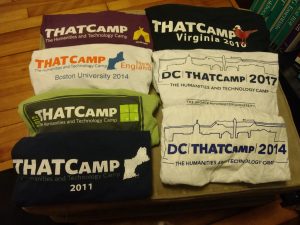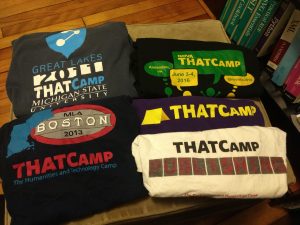The sunsetting of THATCamp is bittersweet for me. It played a fundamental part in both my personal and professional development over its entire span. From the initial reactions on Twitter, and the retrospectives written here, I’m not at all alone. The outpouring of love and respect reflects well the experiences we have shared.
But more broadly, THATCamp has had a lasting influence on Digital Humanities as a professional and intellectual environment. The unconference model introduced a vibrancy to scholarly gatherings that resonated deeply, so much so that others across the country, and indeed across the world, worked to host their own THATCamps. It is no surprise that the Digital Humanities was not the only area to embrace the model. Transparency Camp, sponsored by the Sunlight Foundation, for example, similarly engaged the same approaches and inspiration. Clearly, there was a hunger during that time for new models of communication, much like Twitter became a staple of Digital Humanities communication during the same time, and the two became closely intertwined. (Slack seems to be the next evolution in this space, filling the needs that Google Wave tried unsuccessfully to meet.)
The hard collision between technology and the humanities, though, turned out to be provocative beyond the unconference model. The unofficial motto of “Less Yack, More Hack” (and its predecessor “Less Talk, More Grok”), forced fruitful conversation about the role of technology in the humanities. Do the Humanities require technological knowledge? And will someday the “Digital” qualifier of Digital Humanities become a vestigial redundancy? What does it look like to apply ‘traditional’ modes of humanistic study to technology itself? One of my favorite THATCamps, THATCamp Theory, very nicely brought these together. We continue to see these issues and approaches playing out in monographs and guides for dissertation and tenure and promotion committees from such organizations as the MLA and AHA.
Certainly, those collisions also led to ruptures within the “big tent” that THATCamp often tried to present. Those, too, are still being worked out. And somehow, THATCamp — and I think Digital Humanities in general — missed some potentially fruitful intersections. With just a few exceptions, I saw little representation of the crit-code folks at THATCamps. Similarly with the ed-tech folks. I don’t really have an insight into how those opportunities were missed, but if I could go back, I’d try to rectify that.
Hopefully, though, those interactions have happy homes in other conferences and meetings that I’m not yet connected with. I like to think that THATCamp served as a helpful prompt for large conferences to include unconference-type events and sessions, as THATCamps that were tacked onto the beginning or end of the conference became incorporated into the main structure. Such creative combinations of space, organizations, and practices are spreading and going through their own evolutions. My experiences in this vein started with THATCamp, but I’m profoundly optimistic to see that spirit popping up in other, newer, ways.
Now, my only problem is how to replenish my T-shirt wardrobe.
[Long live AlienWeedMan]






Pingback: Editors’ Choice: THATCamp Roundup